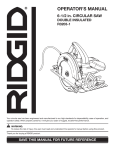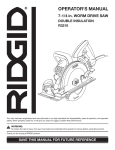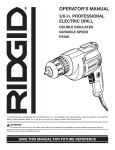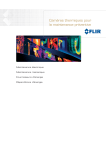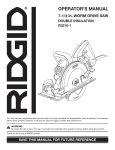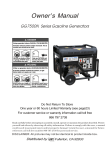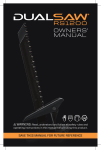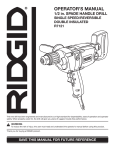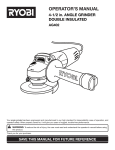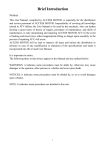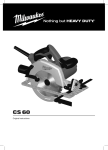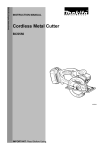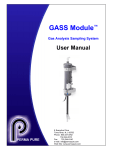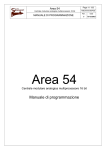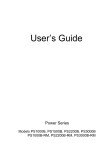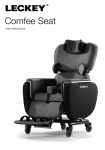Download DUALSAW CS300 MANUAL 2-17
Transcript
TABLE OF CONTENTS Introduction ......................................................................................................... 1 Warranty .............................................................................................................. 1 Product Registration ............................................................................................ 2 General Safety Rules ............................................................................................ 2 Specific Safety Rules ............................................................................................ 5 Symbols ............................................................................................................... 9 Features ............................................................................................................. 10 Assembly ............................................................................................................ 11 Operation ........................................................................................................... 15 Maintenance ...................................................................................................... 18 Part List .............................................................................................................. 20 Accessories ........................................................................................................ 22 Customer Service ............................................................................................... 22 INTRODUCTION The DUALSAW CS 300 has many special features that make this tool very different from other circular saws. Please read and understand this manual before using this product. WARRANTY DUALSAW® – LIMITED ONE YEAR WARRANTY This warranty covers all defects in workmanship or materials in your DUALSAW® for a period of one year from the date of purchase. This warranty does NOT cover blades and accessories. HOW TO GET SERVICE Just return the DUALSAW®, properly packaged and postage prepaid to our Authorized Service Center. You can obtain the location of the Service Center by calling 1-855382-5729. When you request warranty service, you must also present proof of purchase documentation, which includes the date of purchase (sales receipt). We will repair any faulty workmanship, and either repair or replace any defective part, at our option. We will do so without any charge to you. We will complete the work within 90 days or less. WHAT IS NOT COVERED This warranty applies only to the original purchaser and may not be transferred. This warranty only covers defects arising under normal usage and does not cover any malfunction, failure or defects resulting from misuse, abuse, neglect, alteration, modification or repairs by other than the Authorized Service Center. Infusion Brands, Inc. makes no warranties, representation or promises as to the quality or performance of its power tools other than those specifically stated in this warranty. 1 PRODUCT REGISTRATION To get information on product updates, special offers and warranty claims, register your DUALSAW CS 300 on our website www.dualsaw.com Here is what you will need: • Sales Receipt • Machine Serial Number (located on the body of your saw) Serial Number GENERAL SAFETY RULES WARNING! Read, understand and follow all safety rules and operating instructions in this manual before using this product. Failure to follow all instructions listed below may result in electric shock, fire and/or serious personal injury. SAVE THESE INSTRUCTIONS WORK AREA • Always keep your work area clean and well lit. Cluttered benches and dark areas invite accidents. • Do not operate power tools in explosive atmospheres, such as in the presence of flammable liquids, gases, or dust. Power tools create sparks, which may ignite the dust or fumes. • Keep bystanders, children and visitors away while operating a power tool. Distractions can cause you to lose control. ELECTRICAL SAFETY • Avoid body contact with grounded surfaces such as pipes, radiators, ranges & refrigerators. There is an increased risk of electric shock if your body is grounded. • Do not expose power tools to rain or wet conditions. Water entering a power tool will increase the risk of electric shock. If operating the power tool in damp locations is unavoidable, a Ground Fault Circuit Interrupter must be used to supply the power to your tool. Use Electrician’s rubber gloves and footwear to further enhance your personal safety in damp conditions. 2 GENERAL SAFETY RULES • Do not abuse the cord. Never use the cord to carry the tool or to pull the plug. Keep cord away from heat, oil, sharp edges or moving parts. Contact Customer Service if cord is damaged and do not use the saw. Damaged cords increase the risk of electric shock. • Do not use tool if switch does not turn it “ON” or “OFF”. Any tool that cannot be controlled with the switch is dangerous and must be repaired. • When operating a power tool outside, always use an outdoor extension cord with a minimum 13 amperes fuse. These cords are rated for outdoor use and reduce the risk of electric shock. For recommended sizes of extension cords refer to the following table. Minimum Gauge for Extension Cord (AWG) Volts Total Length of Cord 120 V 0 to 25 ft 26 to 50 ft 51 to 100 ft 101 to 150 240 V 0 to 50 ft 51 to 100 ft 101 to 200 ft 201 to 300 ft Ampere Rating AWG AWG AWG AWG More than 0 Not more than 6 More than 6 Not more than 10 More than 10 Not more than 13 More than 13 Not more than 16 18 16 16 14 18 16 14 12 16 16 14 12 14 12 Not Recommended The extension cord must have adequate wire size AWG (American Wire Gauge) Note: for safe, efficient use. Smaller gauge wires have greater capacity (16 gauge wire has more capacity than 18 gauge wire). 3 GENERAL SAFETY RULES PERSONAL SAFETY • Stay alert, watch what you are doing and use common sense when operating a power tool. Do not use tool while tired or under the influence of drugs, alcohol or medication. A moment of inattention while operating power tools may result in serious personal injury. • Dress properly. Do not wear loose clothing or jewelry. Contain long hair. Keep your hair, clothing and gloves away from moving parts. Loose clothes, jewelry or long hair can be caught in moving parts. Keep handles dry, clean and free from oil & grease. Rubber gloves and non-skid footwear are recommended when working outdoors. Wear protective hair covering to contain long hair. • Avoid accidental starting. Carrying tools with your finger on the switch or plugging in tools that have the switch in the “ON” position invites accidents. • Remove adjusting keys or wrenches before switching the tool “ON”. A wrench or a key that is left attached to a rotating part of the tool may result in personal injury. • Don’t overreach. Keep proper footing and balance at all times. Proper footing and balance enables better control of the tool in unexpected situations. • Use safety equipment. Always wear eye protection. Dust mask, non-skid safety shoes, hard hat, or hearing protection must be used for appropriate conditions. TOOL USE AND CARE • Always use clamps or other practical ways to secure and support the work piece to a stable platform. Holding the material in your hand or against your body is dangerous and may lead to loss of control. Hold the tool firmly to prevent loss of control. • Do not force tool. Use the correct tool for your application. The correct tool will do the job better and at a safer rate for which it is designed. • Do not use tool if switch does not turn it “ON” or “OFF”. Any tool that cannot be controlled with the switch is dangerous and must be repaired. • Disconnect the plug from the power source before making any inspections, adjustments, changing accessories, or storing the tool. Such preventative safety measures reduce the risk of starting the tool accidentally. • Store idle tools in a dry and secure place , out of reach of children and other untrained persons. Tools are dangerous in the hands of untrained users. • Maintain tools with care. Keep cutting tools sharp and clean. Properly maintained tools with sharp cutting edges are less likely to jam and are easier to control. Any alteration or modification is a misuse and may result in a dangerous condition. 4 GENERAL SAFETY RULES • Check for misalignment or binding of moving parts, breakage of parts and any other condition that may affect the tool’s operation. If damaged, contact Customer Service before using. Many accidents are caused by poorly maintained tools. Develop a periodic maintenance schedule for your tool. Contact Customer Service to have defective switches replaced. Keep handles dry, clean, and free from oil and grease. • Use only accessories that are recommended by the manufacturer for your model. Accessories that may be suitable for one tool may become hazardous when used on another tool. • While operating, always keep the cord away from the cutting area. SERVICE • Tool service must be performed only by qualified repair personnel. Service or maintenance performed by unqualified personnel could result in a risk of injury. Contact Customer Service for information for repairs. • When servicing a tool, always use only identical replacement parts. Follow instructions in the maintenance section of this manual. Use of unauthorized parts or failure to follow maintenance instructions may create a risk of electric shock or injury. Certain cleaning agents such as gasoline, carbon tetrachloride, ammonia, etc. may damage plastic parts. PLEASE NOTE! DO NOT TOUCH ANY MOVING PARTS WHEN THE MACHINE IS RUNNING. SPECIFIC SAFETY RULES DANGER! KEEP HANDS AWAY FROM CUTTING AREA AND BLADE. • Always keep one hand on the auxiliary handle and the other on the motor housing. When both hands are holding the saw (machine), they cannot be cut by the blades. Keep your body positioned to either side of the saw blade, but not in line with the saw blade. Hold the saw firmly to prevent loss of control. Do not reach underneath the material being cut. The guard cannot protect you from the blade below the material. Do not attempt to remove cut material when blade is moving. Always check that lower guard properly closes before each use. Do not operate saw if lower guard does not move freely and close instantly. Never clamp or tie the lower guard into the open position. If saw is accidentally dropped, lower guard may be bent. Raise the lower guard with the retracting handle and make sure it moves freely and does not touch the blade or any other part. In all angles and depths of cut check the operation and condition of the lower guard spring. 5 SPECIFIC SAFETY RULES If the guard and the spring are not operating properly, they must be serviced before use. Lower guard may operate sluggishly due to damaged parts, gummy deposits, or a buildup of debris. Disconnect the plug from power source. Periodically remove the blade, clean the upper and lower guards and the hub area with a degreaser and wipe it dry, or blow it clean with compressed air. • The lower guard should be retracted manually only for making special cuts such as “Pocket cuts” and “Compound Cuts”. Always raise lower guard by lower guard handle lever. As soon as blade enters the material, the lower guard must be released for all other sawing. The lower guard should operate automatically. • Always observe that the lower guard is covering the blade before placing saw down on a bench or floor. An unprotected, moving blade will cause the saw to jump, cutting whatever is in its path. Be aware of the time it takes for the blade to stop after switch is released. • NEVER hold the piece being cut in your hands or across your leg. It is important to support the material properly to minimize body exposure, blade jamming, or loss of control. • Always hold tool by the insulated gripping surfaces when performing an operation where the cutting tool may contact hidden wiring or its own cord. Contact with a “live” wire will also make exposed metal parts of the tool “live” and shock the operator. • DO NOT use any blades other than the DUALSAW Blades specially designed for this tool. Other blades do not match the mounting hardware & will cause loss of control. • Never use damaged or incorrect flanges (drivers) or bolts. The flanges (drivers) & bolts are specially designed for your saw for optimum performance and safety of operation. • DO NOT turn the saw on while carrying it. Lower guard may be opened by contact with your clothing. Accidental contact with the spinning saw blade could result in serious personal injury. • Never attempt to operate saw with only one blade. Kickback will occur and send the saw towards you resulting in serious injury. HOW TO AVOID KICKBACK Kickback is a sudden reaction to a pinched, bound or misaligned saw blade, causing an uncontrolled saw to lift up and out of the work piece and toward operator. When the blade is pinched or bound tightly by the kerf closing down, the blade stalls and the motor reaction drives the unit rapidly back toward the operator. 6 SPECIFIC SAFETY RULES Kickback is the result of tool misuse and/or incorrect operating procedures or conditions and can be avoided by taking proper precautions as given below: • Maintain a firm grip with both hands on the saw and position your body and arm to allow you to resist kickback forces. Kickback forces can be controlled by the operator, if proper precautions are taken. • Support large panels to minimize the risk of blade pinching and kickback. Large panels tend to sag under their own weight. Supports must be placed under the panel on both sides, near the line of cut and near the edge of the panel. • Do not use dull or damaged blades. Unsharpened or improperly set blades produce narrow kerf causing excessive friction, blade binding and kickback. • Use extra caution when making a “Pocket Cut” into existing walls or other blind areas. The protruding blade may cut objects that can cause kickback. • Depending upon use, the switch may not last the life of the saw. If the switch should fail in the “OFF” position, the saw may not start. If it should fail while the saw is running, the saw may not shut off. If either occurs, unplug the saw immediately and do not use until repaired. Contact Customer Service. • Guard against kickback if the blade binds or the saw stalls and is rapidly driven back towards the operator, release switch immediately. Do not force tool. Stay alert, exercise control. WARNING! • DO NOT let familiarity with your saw make you careless. Remember that a careless fraction of a second is sufficient to cause severe injury. • This saw uses specially designed blades and no other type of blades should ever be used. Other types of blades will not operate safely in this saw & could result in serious personal injury. • If the blades come in contact with the work piece before they reach full speed, it could cause the saw to kickback toward you resulting in serious injury. • Always make sure both blades enter into the material at the same time. Entering with only one blade will cause unexpected kickback, risking serious injury. Therefore, in the case of cutting at an angle, do not approach from the side with only one blade touching, but from the top with both blades entering simultaneously. • The side of the blades cannot be used for cutting. Therefore, in horizontal cuts, make sure saw is not resting on the lower blade. Wedge the work piece to prevent unexpected kickback. 7 SPECIFIC SAFETY RULES ADDITIONAL SAFETY RULES • Be sure to read and understand all instructions. Failure to follow all instructions listed below may result in electric shock, fire and/or serious personal injury. • Know your power tool. Read operator’s manual carefully. Learn the applications and limitations, as well as the specific potential hazards related to this tool. Following this rule will reduce the risk of electric shock, fire or serious injury. • Always wear safety glasses or eye shields when using this saw. Everyday eyeglasses have only impact-resistant lenses; they are NOT safety glasses. Following this rule will reduce the risk of serious personal injury. • Always protect your lungs. Wear a face mask or dust mask if the operation is dusty. Following this rule will reduce the risk of serious personal injury. • Always protect your hearing. Wear protection during extended periods of operation. Following this rule will reduce the risk of serious personal injury. • Inspect the tool’s cord periodically and if damaged contact Customer Service. ALWAYS be aware of the cord location. Following this rule will reduce the risk of electric shock or fire. • Check for damaged parts. Before using the tool, inspect all parts for damage to determine if it would operate properly and perform its intended function. Check for misalignment or binding of moving parts, breakage of parts and any other condition that may affect the tool’s operation. A guard or other part that is damaged should be properly repaired or replaced. Contact Customer Service. Following this rule will reduce the risk of electric shock, fire or serious injury. CAUTION! If the blade becomes twisted or misaligned in the cut, the teeth at the back edge of the blade can dig into the top surface of the work piece causing the blade to climb out of the kerf and jump back toward the operator. WARNING! Some dust created by using power tools contains chemicals known to the State of California to cause cancer and birth defects or other reproductive harm. Some examples of these chemicals are: • Lead from lead-base paints, • Crystalline silica from bricks and cement and other masonry products, • Arsenic and chromium from chemically treated lumber. Your risk from these exposures varies, depending on how often you do this type of work. To reduce your exposure to these chemicals: work in a well ventilated area, and work with approved safety equipment, such as those dust mask that are specially designed to filter out microscopic particles. 8 SYMBOLS Some of the following symbols may be used on this tool. Proper interpretation of these symbols will allow you to operate the tool better and safer. SYMBOL NAME DESIGNATION/EXPLANATION Volts Voltage Amperes Current Hertz Frequency Watt Power Minutes Time Alternating Current Type of Current Direct Current Type of Current No Load speed Rotational speed at no load Class II Construction Double-insulated Construction Per Minute Revolutions or strokes per minute Wet Conditions Alert Do not expose to rain or use in damp areas. Read User Manual To reduce the risk of injury, user must read and understand user’s manual before using the product. Eye Protection Always wear safety goggles or safety glasses with side shields. Face Mask Wear full-face mask when operating this product. Ear Protection To protect your ears for the noise and flying debris, always wear ear protectors or ear plugs. Gloves Always wear gloves when operating this product. No Hands Symbol Failure to keep your hands away from the blades will result in serious injury. Danger Indicates an immediate hazardous situation. Must avoid to prevent death or serious injury. Warning Indicates a potentially hazardous situation, which, if not avoided may result in serious injury. Caution Indicates a potentially hazardous situation, which, if not avoided may result in minor injury. WARNING! The operation of any power tool can result in foreign objects flying into your eyes, which can result in severe injury. Always wear safety goggles or safety glasses with side shields and when needed, a full face mask. 9 FEATURES PRODUCT SPECIFICATIONS • Power: 4.5 Amps • Blade Diameter: 3 1/8” • Cutting Depth: 3/4” • No Load Speed: 8300 RPM • Current Input: 120 V, 60 Hz AC Handle Fig. 1 KNOW YOUR DUALSAW CS 300 Before attempting to use this tool, familiarize yourself with all operating features and Safety rules. (See Figure 1). SPINDLE LOCK The spindle lock allows you to secure the blade when turning the blade screw. LUBRICATION UNIT When cutting soft metals such as aluminum or copper, insert a lubrication stick in the lubrication unit to protect the material and the blades. LOWER GUARD The lower blade guard is there for your protection and safety. It should NEVER be altered for any reason. If it becomes damaged or begins to return slowly or sluggishly, DO NOT use your saw until the damage has been repaired or replaced. 10 ASSEMBLY UNPACKING • Carefully remove the tool and any accessories from the box. Make sure that all the items listed in the packing list are included. • Inspect the tool carefully to make sure no damage occurred during shipping. • Do not discard packaging material until you have carefully inspected and satisfactorily operated the tool. • If any parts are damaged or missing please call 1-855-382-5729 for assistance. PACKING LIST • DUALSAW CS 300 • 1 Set of Multi-Purpose Blades (on saw) • Handle • Blade Wrench • 10 Lubrication Sticks • User Manual • Tool Bag WARNING! If any parts are missing or damaged do not operate this tool until missing parts are replaced. Failure to do so could result in serious personal injury. WARNING! Do not attempt to modify this tool or create accessories not recommended for use with this tool. Any alteration or modification is misuse and could result in a hazardous condition and could result in serious personal injury. WARNING! To prevent accidental starting that could cause serious personal injury, always unplug the saw when assembling parts. 11 ASSEMBLY ATTACHING THE HANDLE • Screw front grip into saw as shown in figure 2. • Use nut to tighten the handle. Fig. 2 REMOVING THE BLADES WARNING! The DUALSAW uses specially designed blades. No other types of blades should ever be used on this tool. Other blades will not operate safely on this saw and could result in serious personal injury. WARNING! Be sure to first unplug the electric cord from the electrical outlet and allow blades to cool before removing blades. 1. P ush the spindle lock to secure the blade. (Fig. 3) Fig. 3 2. Use the blade wrench to unscrew the lock nut. (Fig. 4) 12 Fig. 4 ASSEMBLY 3. Remove lock nut and washer from the blade (fig. 5) 4. Open lower guard of the blade. (Fig. 6) Fig. 6 Fig. 5 5. Lift up and remove “Face B” blade. (Fig. 7) 6. Lift up and remove “Face A” blade (Fig. 8) Fig. 7 Fig. 8 ATTACHING THE BLADES 1. Identify “Face A” and “Face B” on your new set of DUALSAW blades. (Fig. 9) FACE B 2. Open lower guard and place “Face A” blade on saw and fit on the outer arbor shaft . (Fig. 10) FACE A FACE A Fig. 9 Fig. 10 13 ASSEMBLY 3. Place “Face B” blade on top of “Face A” blade and fit on inner arbor shaft. (Fig. 11) 4. P lace washer and lock nut onto shaft. (Fig. 12) Fig. 12 Fig. 11 5. Tighten lock nut using blade wrench tool. (Fig. 13) Fig. 13 EXTEND THE LIFE OF YOUR BLADES The innovative quad force blades allow for extended use. Simply turn the blades around and use the other side. 14 OPERATION DUALSAW BLADES • Keep the blades clean, sharp and properly set. Using a dull blade will place a heavy load on your saw and increases the danger of kickback. Keep extra blades on hand, so sharp blades are always available. • Gum and wood pitch hardened on your blade will slow your saw down. Use gum and pitch remover, hot water or degreaser to remove these accumulations. DO NOT use gasoline. CAUTION! Don’t use the saw when the blade guard is not operating properly. The guard should be checked for correct operation before each use. If you drop your saw, check the lower blade guard and bumper for damage at all depth settings before using. BLADE GUARD SYSTEM • The lower blade guard attached to your saw is there for your protection and safety. It should NEVER be altered for any reason. If it becomes damaged or begins to return slowly or sluggishly, DO NOT use your saw until the damage has been repaired or replaced. Contact Customer Service. Leave the guard in its correct operating position when using the saw. • The guard is operating properly when it moves freely and then readily returns to the closed position. If, for any reason, your lower blade guard does not close freely, contact Customer Service for assistance before using it. OPERATING THE SAW • Clamp the work piece so it will not move during the cut. • Push the switch to ON to start the saw. Always let the blades reach full speed before you begin to cut into the work piece. • Apply steady and even pressure when making a cut. Forcing the saw causes rough cuts and could shorten the life of the saw or cause kickback. • Use the lubricating device (included) when cutting aluminum, copper, stainless steel and cast iron materials, because they have a tendency to smear and adhere to the blades. • Always feed material parallel to the blade. Feeding at an angle can burn the blade and damage the blade teeth. • Don’t place the saw on the part of the work piece that will fall off (after the cut). • To stop the saw, release the switch to the OFF position. 15 OPERATION CAUTION! Maintain control of the saw to make sawing safer and easier. Loss of control of the saw could cause an accident resulting in possible serious injury. STARTING A CUT • Push button and engage trigger on handle to start the saw. Always let the blades reach full speed before you begin to cut into the work piece. • Apply steady and even pressure when making a cut. Forcing the saw causes rough cuts and could shorten the life of the saw or cause kickback. • Make sure both blades enter into the material at the same time; otherwise, unexpected kickback may result, risking serious injury. HOW TO ADJUST THE FEED SPEED • Feed speed is extremely important to get proper results from the saw. Feed speed is determined by the hardness and the thickness of the material you plan to cut. Feed speed is defined by how quickly you push the saw blades through the material. • Feed (for thin materials) the blades down with the teeth protruding only 10-12 mm, then move forward (or backward) for cutting. • Feeding must be parallel to the blade. Feeding at an angle can burn the blade and damage the teeth. CAUTION! • If the feed speed is too slow, the blades will only press down the material rather than cutting it. The blade edges glide and wear down the material. This will cause a poor cut and will cause excessive wear on the blades. • If the feed speed is fast there is a definite risk that the cut might split. The splinter will get bigger and bigger and eventually break risking serious personal injury. • If the feed speed is too high there is a risk that the cut might split and the splinter opening’s volume will not be sufficient to divert all the shaving. The result is a poor cut with significant discharge on the lower side of the material. 16 OPERATION CUTTING DIFFERENT MATERIALS Fig. 14 Fig. 15 FLAT STRIP SOFT METALS Move blades in a 90 degree angle across the piece. (Fig. 14) Apply lubrication sticks through the lubrication system and then cut. (Fig. 15) Fig. 16 Fig. 17 SQUARE TUBE U-SHAPE MATERIAL Move blades to the tube in a diagonal direction. (Fig. 16) Move blades to the U-profile material from the diagonal direction. (Fig. 17) Fig. 18 Fig. 19 ROUND TUBE SHEETS Move blades through the piece in such a way that they come out in a 90 degree angle. (Fig. 18) Move blades into the material in a 90 degree angle then slide blades through the sheet. (Fig. 19 ) 17 OPERATION LUBRICATION STICKS • Use the lubrication sticks to protect your blades and the material when cutting soft metals such as aluminum or copper. • For your convenience, we have included 10 lubrication sticks in your package. Additional lubrication sticks can be purchased at www.dualsaw.com. • Insert a lubrication stick in the lubrication unit as shown in figure 20. • Use the lubrication knob to feed the wax into the blades as need it. Fig. 20 MAINTENANCE GENERAL MAINTENANCE • Tool service must be performed by qualified repair personnel. Service or maintenance performed by unqualified personnel could result in a risk of injury. Contact Customer Service for information on repairs. • When servicing a tool, always use only identical replacement parts. Follow instructions in the maintenance section of this manual. Use of unauthorized parts or failure to follow maintenance instructions may create a risk of electric shock or injury. Certain cleaning agents such as gasoline, carbon tetrachloride, ammonia, etc. may damage plastic parts. • Avoid using solvents when cleaning plastic parts. Most plastics are susceptible to damage from various types of commercial solvents and may be damaged by their use. Use a clean cloth to remove dirt, carbon dust etc. • It is a known fact that electric tools are subject to accelerated wear and possible premature failure when they are used to work on fiber glass boats and sports cars, wallboard, spackling compounds or plaster. The chips and grindings from these materials are highly abrasive for electrical tool parts, such as bearings, brushes, commutators, etc. Consequently, clean the tool even more intensely after working these materials. CLEANING AND STORAGE • Resin and other materials that easily become attached to the sides of the blade often cause the blade to overheat. This means that it can buckle or even split. You must therefore always keep the blade clean. Wash it with a solvent. Never try to scrape the blade clean with a hard object. 18 MAINTENANCE • When the blade is not in use, it should be stored in its original sheath, well cleaned and coated with an antirust agent. LUBRICATION • All of the bearings in this tool are lubricated with a sufficient amount of highgrade lubricant for the life of the tool under normal operating conditions. Therefore, no further lubrication is required. DOUBLE INSULATION • Double insulation is a concept in safety in electric power tools, which eliminates the need for the standard 3-wire ground power cord. All exposed metal parts are isolated from the internal motor components with protecting insulation. Double insulated power tools do not need to be grounded. EXTENSION CORDS • The use of any extension cord will cause some loss of power. To keep the loss at a minimum and to prevent overheating, use an extension cord that is heavy enough to carry the current that the tool will draw. BLADE MAINTENANCE • Don’t use any blades other than the DUALSAW™ CS 300 blades specially designed for this tool. Other blades do not match the mounting hardware and will cause loss of control. • Do not use dull or damaged blades. Unsharpened or improperly set blades produce narrow kerf causing excessive friction, blade binding and kickback. • Keep the blades clean, sharp and properly set. Using a dull blade will place a heavy load on your saw and increases the danger of kickback. Keep extra blades on hand, so sharp blades are always available. • Gum and wood pitch hardened on your blade will slow your saw down. Use gum and pitch remover, hot water or degreaser to remove these accumulations. DO NOT use gasoline. • Don’t attempt to operate saw with only one blade. Kickback will occur and send the saw toward you resulting in serious injury. WARNING! When servicing, use only identical replacement parts. Use of other parts may create a hazard or cause product damage. Contact customer service at 1-855-382-5729 for information on how to obtain replacement parts from an authorized service facility. 19 MAINTENANCE TROUBLESHOOTING PROBLEM CAUSE An unusually large 1. Damaged Teeth amount of sparks 2. Feed speed is too slow 3. Blunt Teeth SOLUTION 1. Replace blades 2. Increase feed speed 3. Mount new set of blades 1. Reduce the feed speed 2. Replace blades 3. Hold saw parallel to work surface Blades break 1. Reduce the feed speed 2. Replace blades 1. Feed speed is too fast 2. Damaged Teeth 3. Blunt Teeth 4. Blades have burned out PART LIST No. description 1 2 3 4 5 6 7 8 9 10 11 12 13 14 15 16 17 18 19 20 21 22 No. description Gearbox 23 Spindle lock pin 24 Spindle lock spring 25 Spring washer 3.5 26 Ball bearing 607-2Z 27 Retaining ring 28 Upper gear 29 Disc spring C 16 GB/T197230 Washer 0.1mm 31 Retaining ring 32 Ball bearing 608-2z 33 Lower gear 34 Ball bearing 6802-2Z 35 Sheath 7.5 36 Gearbox cover 37 Screw M3X4 38 Screw M5X14 39 Big output shaft 40 Bearing MR128-2Z 41 Small output shaft 42 Knob pin 43 Upper blade guard 44 Knob Rubber column Bolt M4X8 Screw GB/T818 M4X6 Insert Spring Lower blade guard Closing ring Blade A Blade B Flange Hex. bolt M5X10 Hex. bolt M8X12 Front handle Hex. bolt M8X16 Acorn nut M8 Bracket Tapping screw ST4.2X28 Nut M7X1 Gear Armature Rubber bearing seat No. description 45 46 47 48 49 50 51 52 53 54 55 56 61 62 63 64 65 66 67 68 69 70 Stator Tapping screw ST4.2X16 Tapping screw ST3.5X16 Left housing Switch Right housing Platen brush housing Copper bushing Carbon brush Cable sheath Cable Key (A)3X8 Brush terminal Spring washer 8 Washer 8 Location pin Wax stick Label 1 Label 2 Label 4 Wrench 20 PART LIST 21 ACCESSORIES The following accessories are currently available at www.dualsaw.com: • Guide Ruler: Allows you to make perfectly straight cuts • Dry Cut Diamond Blades: For stone and masonry • Universal Tungsten Carbide-Tipped Blades • Lubrication Sticks WARNING! Current attachments and accessories available for use with this tool are listed above. Do not use any attachments or accessories not recommended by the manufacturer for this tool. The use of attachments or accessories not recommended can result in serious personal injury. CUSTOMER SERVICE Now that you have purchased your DUALSAW, should you need repair parts or service, simply contact our Customer Service at 1-855-DUALSAW (3825729). Be sure to provide all pertinent facts when you call. You can also check our website www.dualsaw.com for a list of frequently asked questions or e-mail us at [email protected]. MODEL NO. AND SERIAL NO. The model and serial number of this saw will be found on the right side of the body of the saw. Please record the model number and serial number in the space provided below. When calling customer service, always give the following information: • Model Number: CS 300 • Serial Number: ______________ Infusion Brands, Inc. 14375 Myer Lake Cr. Clearwater, Florida 33760 Phone: 1-855-382-5729 www.infusionbrands.com DUALSAW® is a registered trademark of Infusion Brands, Inc. 22 CS300 021714
























